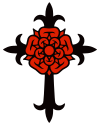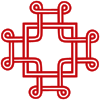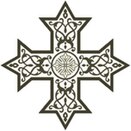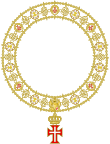| Image
|
Name
|
Description
|
 
|
Armenian cross
|
Symbol of the Armenian Apostolic Church, and a typical feature of khachkars. Also known as the “Blooming Cross” owing to the trefoil emblems at the ends of each branch. A khachkar (cross-stone) is a popular symbol of Armenian Christianity.
|

|
Bolnisi cross
|
Ancient Georgian cross and national symbol from the 5th century AD.
|

|
Byzantine cross-crosslet
|
A Byzantine cross variant seen on several coins and artifacts of the Late Macedonian, Doukas, and Early Komnenos dynasties of the Byzantine Empire (c.950-1092). Combines aspects of the Patriarchal cross, Greek cross, and Calvary cross into a unique variation that may have inspired the later Jerusalem cross.
|

|
Canterbury cross
|
A cross with four arms of equal length which widen to a hammer shape at the outside ends. Each arm has a triangular panel inscribed in a triquetra (three-cornered knot) pattern. There is a small square panel in the center of the cross. A symbol of the Anglican and Episcopal Churches.
|
 
|
Celtic Cross
|
Essentially a Greek or Latin cross, with a circle enclosing the intersection of the upright and crossbar, as in the standing High crosses.
|

|
Coptic ankh
|
Shaped like the letter T surmounted by an oval or circle. Originally the Egyptian symbol for “life”, it was adopted by the Copts (Egyptian Christians). Also called a crux ansata, meaning “cross with a handle”.
|

|
Coptic cross
|
The original Coptic cross has its origin in the Coptic ankh. As depicted in Rudolf Koch’s The Book of Signs (1933).
|

|
New Coptic Cross
|
This new Coptic Cross is the cross currently used by the Coptic Catholic Church and the Coptic Orthodox Church of Alexandria. It evolved from the older Coptic Crosses depicted above. A gallery of Coptic Crosses can be found here.
|
|
|
Ethiopian-Eritrean cross
|
This is one of many variations of Ethiopian crosses and Eritrean crosses generally made up of latticework, used by Ethiopian Christians and Eritrean Christians.
|

|
Cross and Crown
|
A Christian symbol used by various Christian denominations, particularly the Bible Student movement and the Church of Christ, Scientist. It has also been used in heraldry. The emblem is often interpreted as symbolizing the reward in heaven (the crown) coming after the trials in this life (the cross) (James 1:12).
|

|
East Syrian cross
|
Church of the East cross.
|

|
Gamma cross
|
A Greek cross. Depicted, as an instance, on the vestments of the hierarchs of the Eastern Orthodox Church
|

|
Huguenot cross
|
The symbolism of the Huguenot cross is particularly rich. The cross as an eminent symbol of the Christian faith, represents not only the death of Christ but also victory over death and impiety. This is represented also in the Maltese cross. It is boutonné, the eight points symbolising the eight Beatitudes (Matthew 5:3–12) Between the arms of the cross is the stylised fleur-de-lys (on the French Coat of Arms), each has 3 petals; the total of twelve petals of the fleur-de-lys signify the twelve apostles. Between each fleur-de-lys and the arms of the Maltese cross with which it is joined, an open space in the form of a heart, the symbol of loyalty, suggests the seal of the French Reformer, John Calvin. The pendant dove symbolises the Holy Spirit (Romans 8:16). In times of persecution a pearl, symbolizing a teardrop, replaced the dove.
|

|
Maltese cross
|
An eight-pointed cross having the form of four “V”-shaped elements, each joining the others at its vertex, leaving the other two tips spread outward symmetrically. It is the cross symbol associated with the Order of St. John since the Middle Ages, shared with the traditional Knights Hospitaller and the Sovereign Military Order of Malta, and by extension with the island of Malta.
|
|
|
Order of Christ Cross
|
A red Greek cross starting initially as wide permanent and widening only at its end to the outside arms, with a white inner simple Greek cross. Not to be confused with the Cross of Saint John nor the Maltese cross. It’s the insignia of the Military Order of Christ (Portuguese: Ordem Militar de Cristo), former Knights Templar order as it was reconstituted in Portugal after the Templars were abolished on 22 March 1312, being the Grand Master the current President of Portugal. It’s an honorific symbol of the Portuguese Navy, and current symbol of the Portuguese Air Force.
|
|
|
Supreme Order of Christ Cross
|
A red Latin cross starting initially as wide permanent and widening only at its end to the outside arms, with a white inner simple Latin cross. Not to be confused with the Cross of Saint John nor the Maltese cross. It’s the symbol of the Papal Supreme Order of Christ (Italian: Ordine Supremo del Cristo), the highest order of chivalry awarded by the Pope, and it’s the Papal parallel to the Order of Christ in both Portugal and Brazil.
|

|
Maronite cross
|
Cross of the Syriac Maronite Church. Reminiscent of the Papal cross and cross of Lazarus.
|

|
Nestorian cross
|
In Eastern Christian art found on tombs in China, these crosses are sometimes simplified and depicted as resting on a lotus flower or on a stylized cloud.
|

|
Occitan cross
|
Based on the counts of Toulouse’s traditional coat of arms, it soon became the symbol of Occitania as a whole.
|

|
“Carolingian cross”
|
Cross of triquetras, called “Carolingian” by Rudolf Koch for its appearance in Carolingian-era art.[8] |

|
Rose Cross
|
A cross with a rose blooming at the center. The central symbol to all groups embracing the philosophy of the Rosicrucians.
|

|
Serbian cross
|
A Greek cross with four Cyrillic S’s (C) in each of its angles, inspired by the imperial motto of the Palaiologos dynasty, but with the meaning of “Only unity saves the Serbs” (Само Слога Србина Спасава), generally attributed to Serbian patron saint, St. Sava. A national symbol of Serbia and symbol of the Serbian Orthodox Church.
|

|
Shield of the Trinity
|
Early variant of the Trinity Shield with the Christian cross on the bottom portion.
|


|
Suppedaneum cross
|
Also known as the Russian cross, Slavic, Slavonic cross, or Orthodox, East Orthodox, Russian Orthodox cross. A three-barred cross in which the short top bar represents the inscription over Jesus’ head, and the lowest (usually slanting) short bar, placed near the foot, represents his footrest (in Latin, suppedaneum). This cross existed in a slightly different form (with the bottom crossbeam pointing upwards) in Byzantium, and it was changed and adopted by the Russian Orthodox Church and especially popularized in the East Slavic countries.
|
 
|
Macedonian Cross, also known as Veljusa Cross.
|
Macedonian Christian symbol, symbol of the Macedonian Orthodox Church.
|

|
Anuradhapura cross
|
A symbol of Christianity in Sri Lanka.
|

|
Nordic cross/Scandinavian cross
|
The cross design represents Christianity, and the characteristic shift of the center to the hoist side is early modern, first described as the Danish civil ensign (Koffardiflaget) for merchant ships in a regulation of 11 June 1748, which specified the shift of the cross center towards the hoist as “the two first fields must be square in form and the two outer fields must be 6/4 lengths of those”.
|

|
West Syrian cross
|
Syriac Orthodox cross.
|

|
Gion-mamori mon
|
The mon of the Gion Shrine, depicting two crossed amulets, adopted by Kakure Kirishitans persecuted under the Tokugawa Shogunate.[9] |


































































Recent Comments